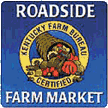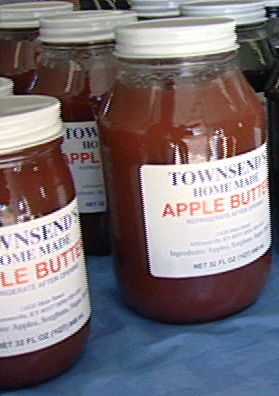
Producing pure natural sweetener for over 100 years.

Discover the great taste of one of nature’s most perfect foods.Order a jar or two of Townsend’s Sweet Sorghum today.
Townsend’s Sweet Sorghum is the healthful alternative to sugar. It’s great on biscuits or toast. You can put it in coffee or hot tea as an all-natural sweetener. Plus, you can use it as a sugar substitute in recipes to enhance the nutritional value of you cooking.
The sorghum contains many of the daily recommended requirements of several vitamins and minerals your body needs including: Potassium, Phosphorous, & Iron. Our Sorghum contains no chemical additives.
Products
Click on the products below to learn more.
Who are we?
Townsend’s Sorghum has been produced on the same farm in Jeffersonville, Kentucky since the late 1800s. Townsend’s Sorghum is currently being produced by the fifth generation family patriarch Danny Townsend. Danny took the reins of the family business in the mid-1980s. Since that time, Townsend’s Sorghum has been instrumental in sorghum’s revival.
In the old days of sorghum production, producing sorghum syrup was very labor intensive. When it is time to harvest the sorghum cane, the first step in the process was to cut each plant by hand. Once the plant has been cut down, the plant was topped. When a plant was topped, it meant the seed heads at the upper most part of every sorghum cane plant was cut off by hand. This was where the producer got next year’s crop of sorghum seeds. The leaves were then cut off so you had a long “sorghum cane sticks.” From there, the sticks were fed by hand into squeezing mechanism called a mill. The mill was similar to an old wringer mechanism on an antique washing machine. The squeezing mechanism was turned by a mule that was attached to a “sweep pole” about thirty feet long. As the mule walked in a circle, it caused the rollers of the equipment to squeeze the juice out of the cane. The juice was then boiled over a wood fire where all the impurities were then skimmed off the top. As the impurities were boiled off, water in the plant evaporated, and the juice thickened to the consistency of syrup. The sorghum was then put in bottles, jugs, and barrels to be sold.
Today, mechanized equipment has replaced some of the back breaking labor required to harvest and squeeze the plant. In addition, Danny Townsend has created a state-of-the-art production facility (they only use the mule for festival appearances) where he is able to supply his customers with great tasting Townsend’s Pure Cane Sorghum all year round. Danny has always been an innovator. He is a charter member of the National Sweet Sorghum Producers and Processors Association. In addition, many of Danny’s planting and harvesting techniques have been instrumental in bringing sorghum back from the brink of extinction. In addition, Townsend’s Pure Cane Sorghum has been voted National Champion Sweet Sorghum, not once, but twice.
Danny Townsend and his family have always strived to produce the best tasting, healthiest sorghum available. Don’t take our word for it. Order a jar or two of Townsend’s Pure Cane Sorghum and see for yourself.


History Lesson
Sweet sorghum is a grass of Old World origin. The name "sweet sorghum" is used to identify varieties of sorghum, Sorghum bicolor (L.) Moench, that are sweet and juicy. A United States patent officer introduced sweet sorghum to American in 1853. It is a native of Africa, a drought-resistant, heat-tolerant member of the grass family.
The Department of Agriculture conducted numerous experiments on the extraction of sucrose from sorghum and on crystallization of sorghum syrup. It was hoped to reduce reliance on cane sugar imports and on slave-hungry sugar plantations. Farmers in the South and lower Midwest welcomed the cheap, local alternative to extract dry sugar from the syrup. But, it proved too difficult to extract dry sugar from the syrup.
The syrup was an important sweetener for many small communities well into this century and even today is still locally important. In the 1860's sorghum cultivation was concentrated in the Midwest, but by the 1890's it had become predominately a southern crop. Production reached a peak of 24 million gallons in the 1880's and then declined over the next century in the face of competition from glucose syrups. By 1975, the U.S. Agricultural Census reported just 2,400 acres producing less than 400,000 gallons of syrup. There has been a recovery from this low production with 25,000 to 30,000 acres planted for syrup today. Kentucky and Tennessee are the states with the largest acreage.
This information is supplied by the National Sweet Sorghum Producers and Processors Association. Used with permission.

Visit Our Farm
You are invited to visit us on the farm. We are located at:
11620 Main Street
Jeffersonville, KY 40337
Some of the things we offer while in season are: strawberries, broccoli, cauliflower, cabbage, summer squash, green beans, potatoes, tomatoes, peppers, cantaloupes, watermelons, sweet corn, pumpkins, honey, sorghum. Plants: tomatoes, peppers, cole crops. Sep-Oct: sorghum making on the farm. Visit our pay lake: Apr-Sep, day or night fishing, fish fries, tournaments. Call for dates and times. Grand Champion Sorghum in National Sorghum Competition.
Healthy Choices
In an effort to live healthier lives, many people think they have to compromise. By that we mean, they think they have to choose between bland, tasteless food that is high in nutrients or great tasting food that is high in fat with no nutritional value. Well compromise no more. We want to introduce you to a great tasting product that is all natural, high in nutrients, and great in taste. It’s called Townsend’s Sorghum.
Townsend’s Sorghum is the healthful alternative to sugar. In fact, it contains many of the daily recommended requirements of several vitamins and minerals you need everyday including potassium, phosphorous, and iron. You see Townsend’s Sorghum is an all natural sweetener because it contains no chemical additives. Sorghum is made from a sweet sorghum plant. The sorghum cane looks like a corn stalk with no ears of corn growing on it.
At Townsend’s Sorghum, we grow our own sorghum cane on our fifth generation family farm. When we harvest the sorghum cane, it is put into a press and all the natural juice is squeezed out of the plant. The sorghum juice is then heated to remove all the impurities. As the sorghum juice boils, the impurities rise to the top where they are skimmed off and removed. The heating process also causes the sorghum juice to thicken. Good sorghum has a thickness similar to that of honey, although sorghum tends to have a sweeter taste.
In addition to having lots of vitamins and nutrients, Townsend’s Sorghum is versatile. Most people think of sorghum simply as a breakfast food that is eaten on biscuits or bread, just like jams and jellies, but that is only the beginning. You can use Townsend’s Sorghum like sugar in your coffee or hot tea. You can use Townsend’s Sorghum in place of sugar for cakes, pies and cookies. Townsend’s Sorghum can be used in all sorts of vegetable dishes from slaws and salads, to green beans and corn. It can also be used on meats and in stews or chilies. Once you try Townsend’s Sorghum you’ll find uses for it in nearly everything you cook

Bluegrass & Backroads

Just the Facts



Kentucky Farms are Fun is a great website to learn more about agritourism in Kentucky.
Resources
We also recommend visiting the Kentucky Proud website to learn more about agriculture and produce in Kentucky.





